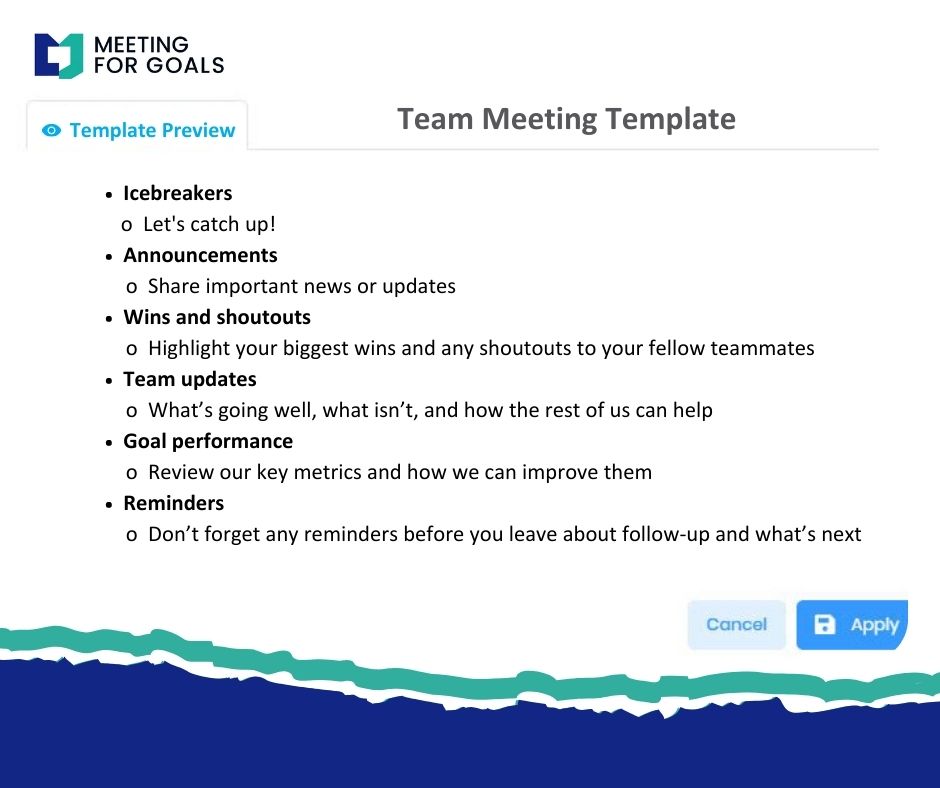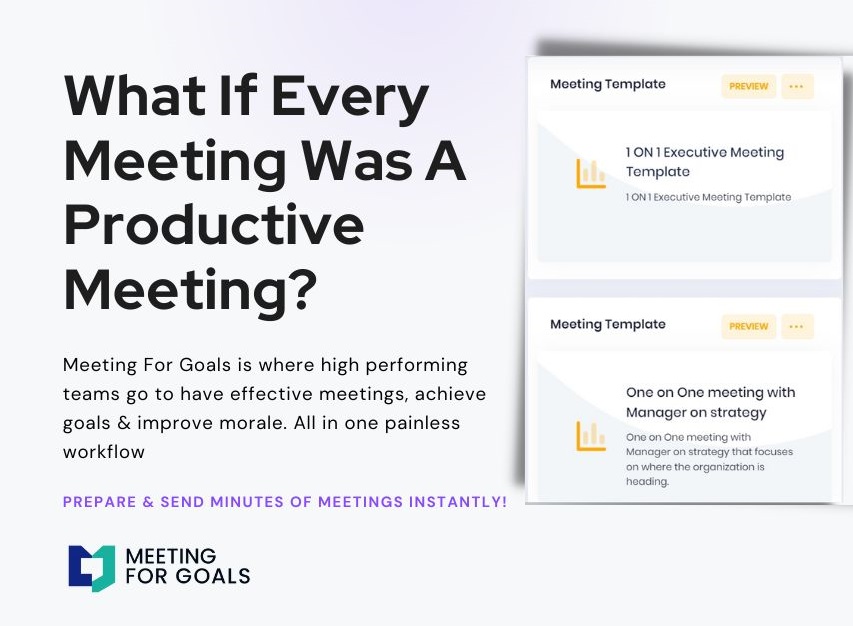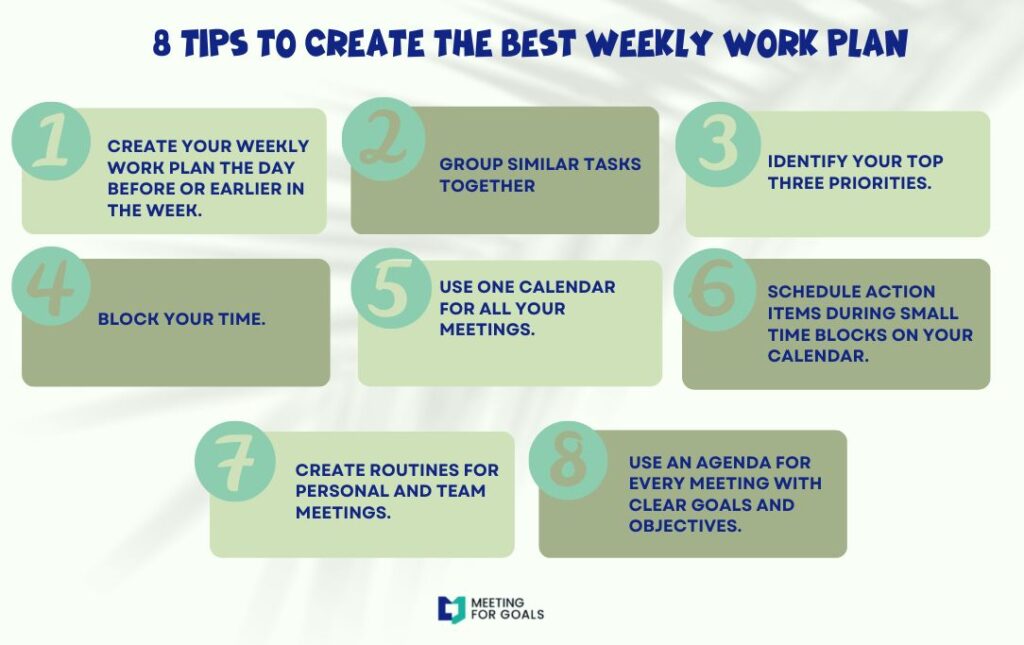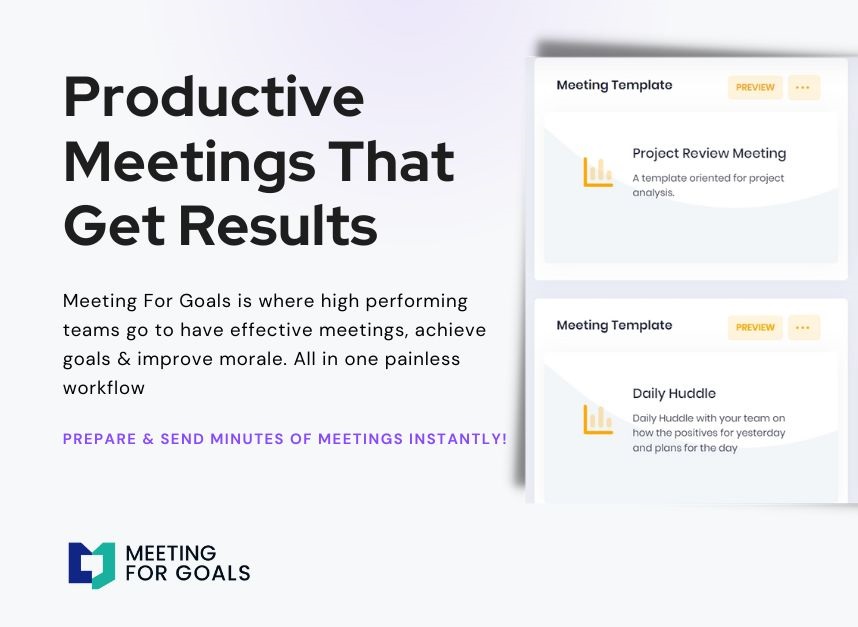Mastering Meeting Etiquette: How High-Performing Teams Run Productive Meetings
Excerpt: In today’s fast-paced business world, time is one of your most valuable assets—especially in meetings. Yet, many executives still struggle with unproductive sessions. These sessions can derail focus and drain energy. The fix? Mastering meeting etiquette. This guide breaks down the six essential pillars of effective meetings. It is tailored for executive leaders managing teams of 40–70 employees. With the right habits—and tools like Meeting For Goals—you can turn meetings into high-impact, goal-driven sessions. These sessions boost collaboration, accountability, and results.
Meetings are where key decisions are made, strategies are aligned, and teams collaborate. However, when they’re not run effectively, they become time-wasters that kill momentum. For growing teams of 40–70 employees, led by ambitious executives, mastering meeting etiquette is more than a courtesy—it’s a business advantage.
At Meeting For Goals, we help high-performing teams conduct efficient, focused meetings. Our meetings align with business objectives. Our meeting management software simplifies planning, encourages accountability, and supports better communication— so your team gets more done in less time.
In this guide, we’ll walk you through the six pillars of effective meeting etiquette. Whether you’re a Director, VP, or part of the C-suite, these strategies will help you lead meetings that drive real results.
Before we dive in, check out our free meeting templates to get a head start on structuring your sessions: Meeting Templates.
2 Minute Video
Watch a 2-minute demo of our meeting management software in action
Section 1: Preparing for the Meeting
Preparation is where successful meetings begin. Without it, meetings tend to spiral into confusion and wasted time. For executives managing mid-sized teams, preparing strategically ensures that every meeting contributes to your company’s goals.
1.1 Set a Clear Agenda
A clear agenda keeps everyone focused. It should include:
- The meeting’s purpose
- Key discussion points
- Time allocations
- Desired outcomes
When everyone knows what’s on the table, they’re more likely to come prepared and stay engaged. Using Meeting For Goals, you can create and share agendas that are directly tied to your strategic priorities.
According to Harvard Business Review, poorly planned meetings cost U.S. companies billions in lost productivity each year. A well-structured agenda can dramatically reduce wasted time and increase meeting ROI.
1.2 Send Invitations with Purpose
Don’t invite everyone—invite intentionally. Only include people who are essential to the discussion or decision-making process. Each invite should clearly explain:
- Why the person is invited
- What they’re expected to contribute
- What prep work (if any) is required
Meeting For Goals allows you to customize attendee lists based on roles, projects, or departments. This ensures every participant is necessary and prepared.
1.3 Share Materials in Advance
If your team doesn’t have the right information before the meeting, they can’t contribute effectively. Attach relevant reports, data, or presentations to the invite. This ensures that everyone starts on the same page.
Our platform makes it easy to upload and distribute materials alongside your agenda. This saves time during the meeting and leads to more informed discussions.
Want to streamline your prep process? Sign up for Meeting For Goals here: Meeting For Goals Registration.
Adding an Agenda
How to add an agenda instantly on Meeting For Goals
Section 2: Punctuality and Attendance
Time is your team’s most limited resource. Respecting it begins with showing up on time and being present.
2.1 Start and End on Time
When meetings run late, it sends the message that other people’s time isn’t valuable. Starting and ending on time sets a professional tone and keeps your day running smoothly.
Meeting For Goals helps by sending automated reminders and countdowns to keep meetings on schedule.
2.2 Lead by Example
As an executive, your behavior sets the tone. Show up early, start promptly, and stay engaged. Encourage your team to do the same by:
- Blocking buffer time between meetings
- Using calendar alerts
- Reinforcing the importance of punctuality in 1:1s
2.3 Address Absenteeism
When decision-makers skip meetings, it slows everything down. Follow-up meetings become necessary, and progress stalls. Use Meeting For Goals to track attendance trends. If a team member frequently misses meetings, it’s a signal to check in and address the underlying issue.
For more on how meeting culture impacts performance, check out this Forbes article on how to run better meetings.
Section 3: Respectful Communication
Great communication is what separates effective meetings from frustrating ones. Respectful, clear dialogue fosters collaboration and drives better outcomes.
3.1 Practice Active Listening
Active listening means giving your full attention, acknowledging what’s being said, and responding thoughtfully. It builds trust and encourages honest input.
Meeting For Goals supports this with features like speaker queues and discussion timers. These tools ensure everyone has a chance to contribute without interruptions.
3.2 Encourage Constructive Feedback
Feedback should be welcomed, not feared. For this to happen, it must be delivered respectfully and received with an open mind.
Our platform includes post-meeting surveys and anonymous feedback tools. These features help leaders gather honest input and continuously improve the meeting experience.
3.3 Maintain a Professional Tone
Even in heated discussions, professionalism is key. Avoid sarcasm, interruptions, or dismissive comments. Stick to the topic and focus on solutions—not blame.
Meeting For Goals offers communication guidelines and customizable templates. These tools help reinforce respectful conduct across your team.
Section 4: Inclusivity and Participation
A meeting where only a few voices dominate isn’t effective—it’s discouraging. Ensuring inclusive participation leads to better decisions and a more engaged team.
4.1 Promote Equal Participation
Encourage input from everyone, not just the loudest voices. Use tools like:
- Round-robin prompts
- Anonymous polls
- Breakout discussions
These tactics help introverted or junior team members feel comfortable contributing. Meeting For Goals makes it easy to implement these features, giving every team member a voice.
4.2 Facilitate, Don’t Dominate
The role of a meeting leader is to guide the conversation—not control it. A good facilitator:
- Keeps discussions on track
- Summarizes key points
- Encourages quieter team members to share
Our software includes live agendas and shared notes. This allows facilitators to manage participation without losing focus.
4.3 Handle Conflict with Care
Disagreements are natural, especially in high-performing teams. The key is to manage them respectfully. Set ground rules like:
- No personal attacks
- Stick to the facts
- Seek common ground
Meeting For Goals includes decision-making templates and conflict resolution tools. These features guide teams through tough conversations.
Want more tools to foster inclusive meetings? Explore our free templates: Meeting Templates.
Section 5: Action Items and Accountability
The real value of a meeting lies in what happens after it ends. Without clear action items and accountability, even great discussions go nowhere.
5.1 Document Key Takeaways
Meeting notes should capture decisions, assigned tasks, and deadlines. This ensures clarity and prevents miscommunication. Meeting For Goals automatically generates meeting summaries and action logs. This way, nothing falls through the cracks.
5.2 Assign Responsibilities Clearly
Avoid vague assignments like “someone should follow up.” Every task needs:
- A specific owner
- A clear deliverable
- A deadline
Our platform lets you assign tasks in real time, link them to individual team members, and track progress over time.
5.3 Follow Up Consistently
Follow-through is where execution happens. Schedule check-ins, review progress, and adjust timelines as needed to keep momentum going. Meeting For Goals integrates with your calendar and project management tools. So, deadlines and reminders are always synced.
Section 6: Continuous Improvement
Even with great etiquette, there’s always room to grow. Make continuous improvement a part of your meeting culture.
6.1 Collect Feedback Regularly
After each meeting, ask: What went well? What could be better? Use quick surveys or anonymous forms to gather honest input. Meeting For Goals makes this easy with built-in feedback tools.
6.2 Review Meeting Metrics
Track key indicators like:
- Meeting length
- Attendance rates
- Task completion
These metrics help you identify patterns and adjust your approach.
6.3 Evolve Your Format
Don’t be afraid to experiment. Try different formats, like stand-ups, async updates, or hybrid models. The goal is to find what works best for your team.
For additional insights, check out this guide from Atlassian on running effective team meetings.
Conclusion
Mastering meeting etiquette isn’t just about being polite—it’s about running your business more effectively. For executive leaders managing mid-sized teams, following these six pillars—preparation, punctuality, communication, inclusivity, accountability, and continuous improvement—can dramatically improve team alignment, morale, and results.
At Meeting For Goals, we’re here to support your journey toward better meetings. Our platform simplifies every aspect of the process, from planning and facilitation to follow-up and performance tracking.
Ready to transform your meetings?
- 👉 Try Meeting For Goals today: Meeting For Goals Registration
- 👉 Explore our free meeting templates: Meeting Templates
- 👉 Learn more about how we help teams run better meetings: Meeting For Goals
Make every meeting count—because time is too valuable to waste.




